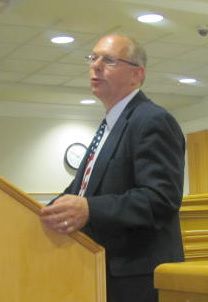NORTH WILDWOOD ─ City residents and special guest, County Clerk and Historian Rita Fulginiti, gathered June 2 in council chambers for the third celebration of Anglesea Day. It was a day for remembrance and carrying the same passion and dedication for the city as those who went before.
City Clerk and Historian Scott Jett gave a presentation focused on the first four mayors of Anglesea, whose combined years of service spanned from 1885 to 1906.
Jett, who has conducted extensive research on historical Anglesea, began his presentation with the life of William Tompkins.
He was an Army doctor. Tompkins served during the Civil War in a cavalry regiment from Oregon. His service continued after the war in Arizona where his daughter was born.
Tompkins’ wife, Sarah, was a cousin to Frederick Swope, who owned the Five Mile Improvement Company; thus, in 1879, Tompkins returned east and settled in Anglesea, selling lots and serving as the first postmaster.
Tompkins’ tenure as mayor ended with his death from tuberculosis, presumably contracted during his Army service. “He gave his all to our county and to Anglesea,” Jett said.
According to Jett, 10 percent of deaths in males over 50, at that time, were due to tuberculosis.
After Tompkins came Peter Monroe, a New York City native. After purchasing property on Spruce Avenue, Monroe had a “cottage” erected that, according to Jett, was more “like a mansion.”
Settling in Anglesea, Monroe became involved in politics, serving twice as mayor and on borough council. After two terms, Monroe turned his attention to the fishing industry and moved elsewhere.
During Monroe’s tenure, street improvements took up most of the council’s time. According to Jett, layers of gravel and seagrass were laid to “soften carriage rides.”
“They (council) had foresight that was incredible,” said Jett. Also during Monroe’s time, manufacturer Henry Otten arrived, buying lots at the southern end of the borough and changing the course of Five Mile Island forever.
In 1888, Edwin Hewitt became the first mayor “to fight drainage.” “And we are still fighting today,” said Jett with a smile.
Keeping Anglesea above water proved difficult. Hewitt rose to the challenge. After approving the West Jersey Railroad right-of-way, Hewitt turned his attention to garbage removal and building the first bulkheads.
Edward Shivers, who served in a variety of functions as well as mayor, was an “intelligent, well-read man” and a “pioneer of Anglesea.”
Originally from Camden, Shivers worked as a plasterer by trade and was influential in the early days of the First Baptist Church of Anglesea, the first congregation on the island.
Shivers entertained talks of a bridge connecting Anglesea to the mainland in 1900, and automobiles clattered onto the island in 1904. The first elevated boardwalk, stretching around Hereford Inlet, was erected and Margaret Mace, a local schoolteacher, graduated from medical school in 1905 and returned to serve the people of Anglesea as a physician.
Electric lights also came to Anglesea, although running water would not come to the island until Henry Otten’s waterworks.
Augustus Hilton, native of Pleasantville, witnessed the final days of Anglesea and the dawn of a new era for the burgeoning cities of Wildwood and North Wildwood.
“The best things were happening at the southern end of the borough,” Jett explained, thanks to Otten. “Wildwood was booming.”
Amenities, new hotels, and an ocean-facing boardwalk shifted the focus away from Hereford Inlet as the center of commerce to Wildwood.
Otten approached council and petitioned for electric lights, and his request was granted. Otten was the “largest provider of revenue” for the borough.
Though not entirely “honest” in the construction of his canal, Otten pushed the island into the modern age, prompting the first name change discussion on May 16, 1906.
A year later, Anglesea became North Wildwood, and Hilton soon left, moving to Harvey Cedars on Long Beach Island.
“It was really good, Scott,” Fulginiti said after the presentation.
Jett said he owes much to the early clerks of Anglesea for their careful records: “They are my heroes,” Jett said.
Jett also revealed that he is writing a book on Anglesea from 1885 to 1906.
A historical maker was also unveiled at 16th Avenue commemorating the “new” boardwalk constructed in the early 1900’s.
Though the days of Anglesea cannot come again, the same passion and dedication for a safe, thriving community continue. As stated by Shivers, “They did pretty good.”
To contact Rachel Rogish, email rrogish@cmcherald.com.








